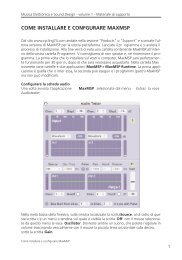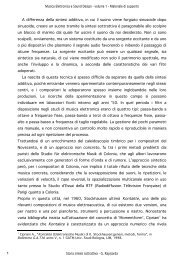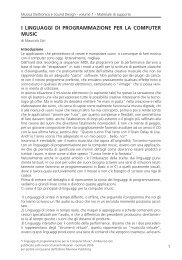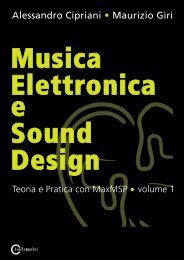programming with max/msp - Virtual Sound
programming with max/msp - Virtual Sound
programming with max/msp - Virtual Sound
You also want an ePaper? Increase the reach of your titles
YUMPU automatically turns print PDFs into web optimized ePapers that Google loves.
1.2<br />
18<br />
Theory<br />
1000 Hz was chosen as the reference frequency for the phon, because at this<br />
frequency, a measurement in phon and one in dB often coincide. (100 dB<br />
corresponds to the feeling of 100 phon, 80 dB of 80 phon, etc.) For example,<br />
if we examine the 60 phon curve, 60 dB of pressure are necessary at 1000 Hz<br />
to produce a certain sensation, but as the pitch drops in frequency, more and<br />
more dB are required to maintain the same sensation in the listener.<br />
(...)<br />
other sections in this chapter:<br />
Waveform<br />
The sinusoid<br />
Other waveforms<br />
Bipolar and unipolar waves<br />
Logarithmic calculation of pressure sounds in db<br />
1.3 CHANGING FREQUENCY AND AMPLITUDE IN TIME:<br />
ENVELOPES AND GLISSANDI<br />
Envelopes of acoustic instruments<br />
Envelopes of synthetic sounds<br />
Glissandi<br />
Exponential and logarithmic curves<br />
1.4 THE RELATIONSHIP BETWEEN FREQUENCY AND<br />
MUSICAL INTERVAL<br />
1.5 INTRODUCTION TO WORKING WITH SAMPLED SOUND<br />
Digitalization of sound<br />
1.6 INTRODUCTION TO PANNING<br />
ACTIVITIES<br />
• interactive examples<br />
TESTING<br />
• questions <strong>with</strong> short answers<br />
• listening and analysis<br />
SUPPORTING MATERIALS<br />
• fundamental concepts<br />
• glossary<br />
Paragraph 1.2 - Frequency, amplitude, and waveform<br />
from “Electronic Music and <strong>Sound</strong> Design” Vol. 1 by Alessandro Cipriani and Maurizio Giri<br />
© ConTempoNet 2010 - All rights reserved







